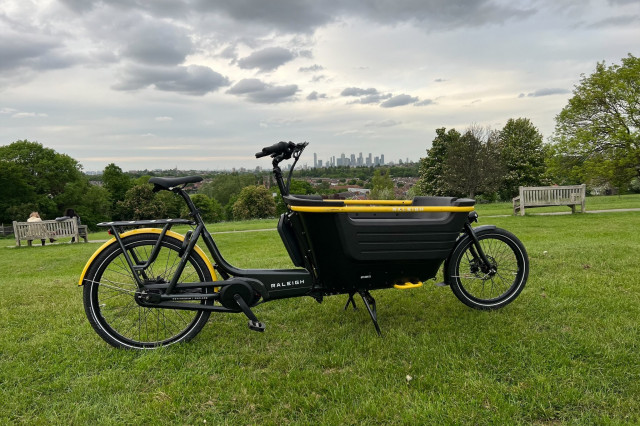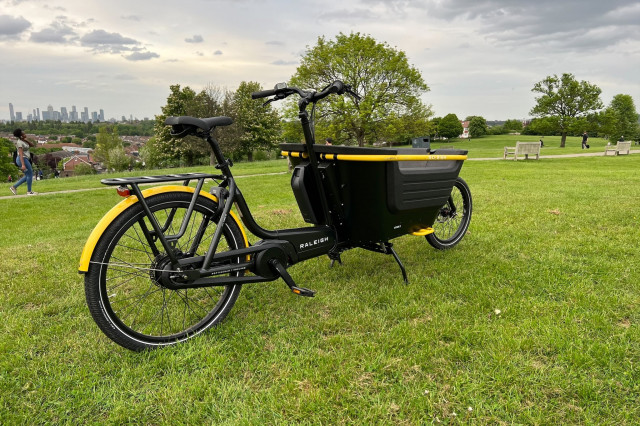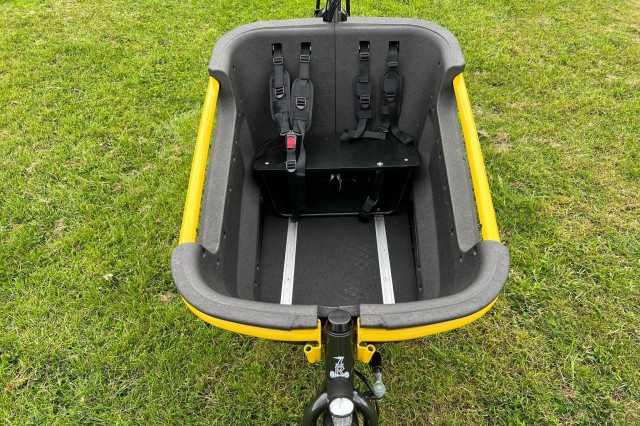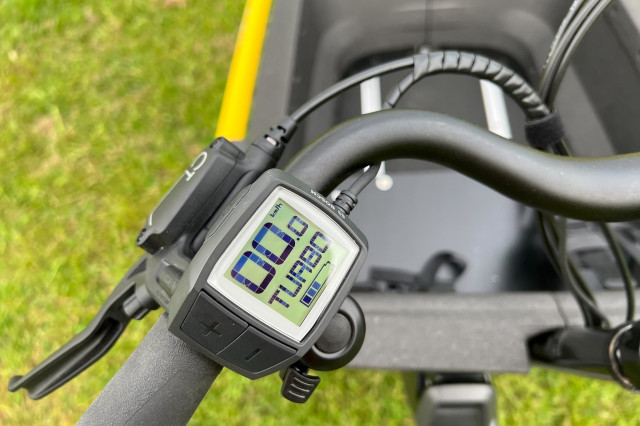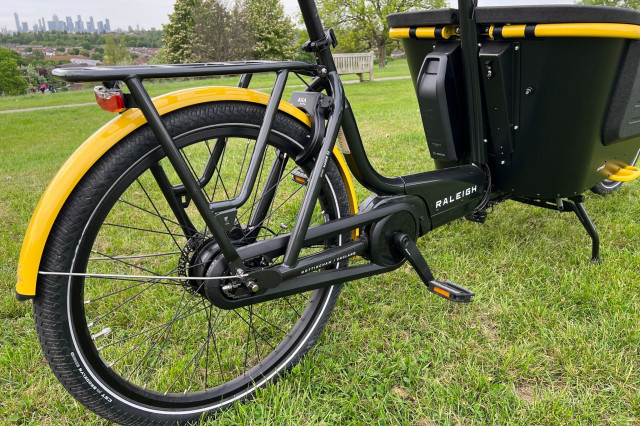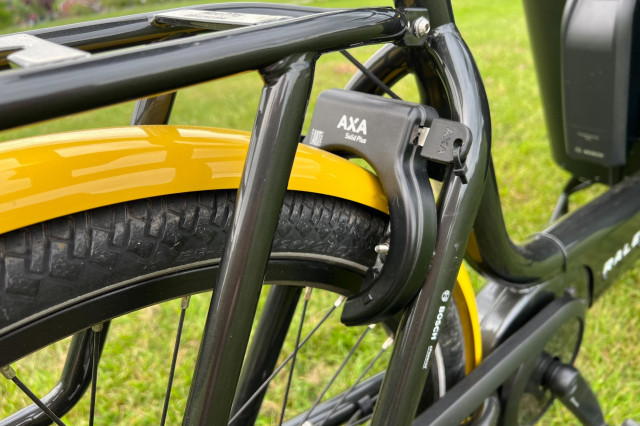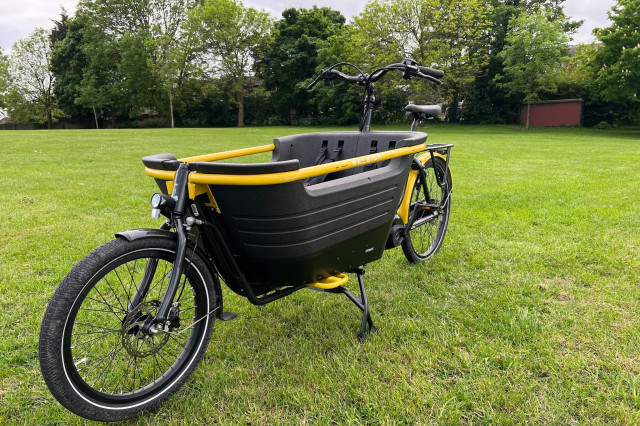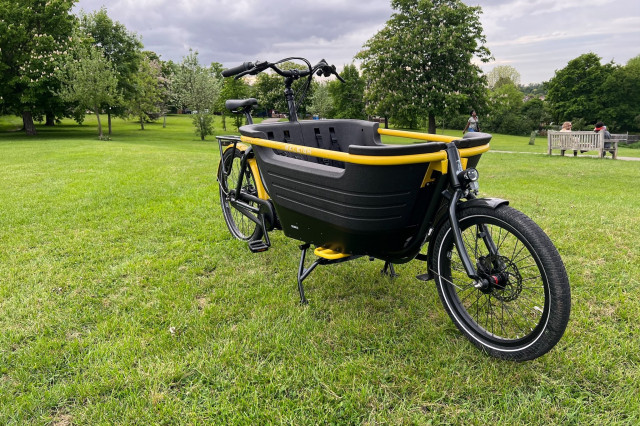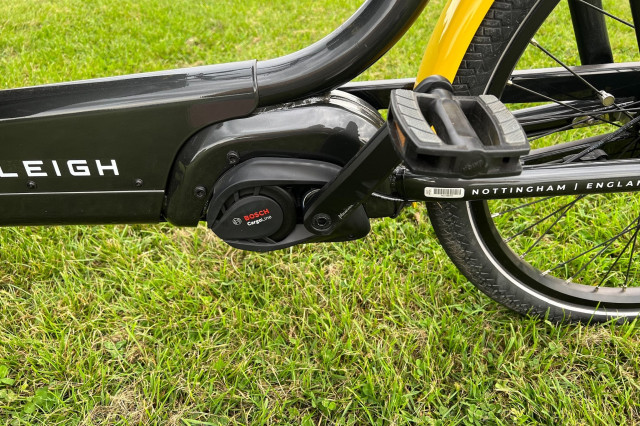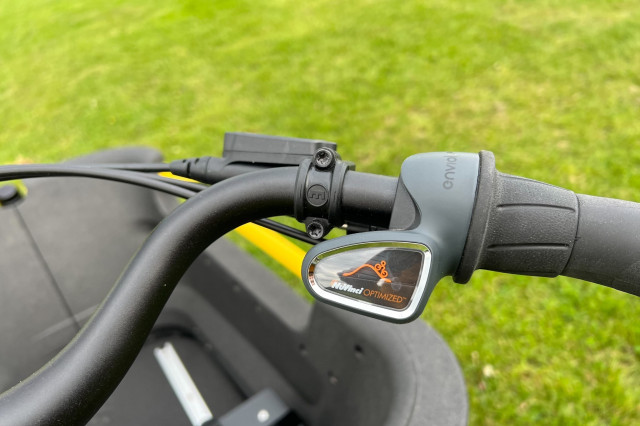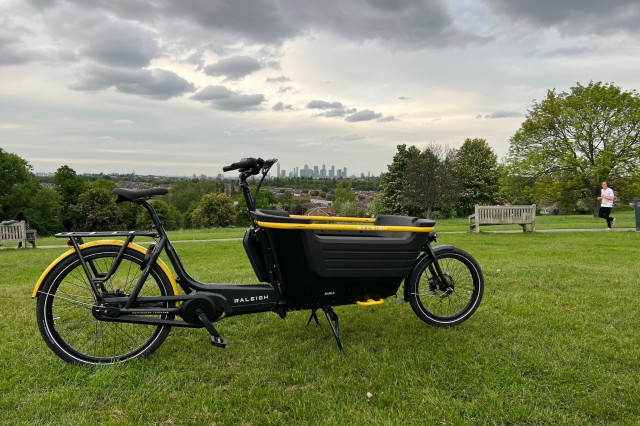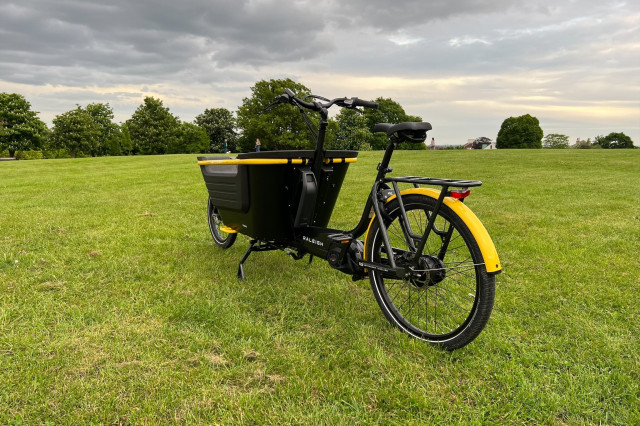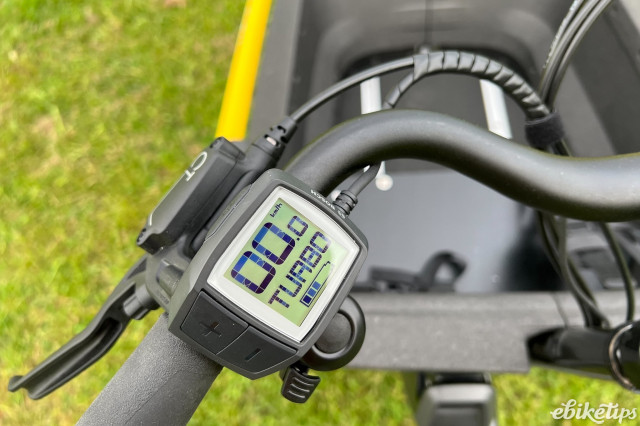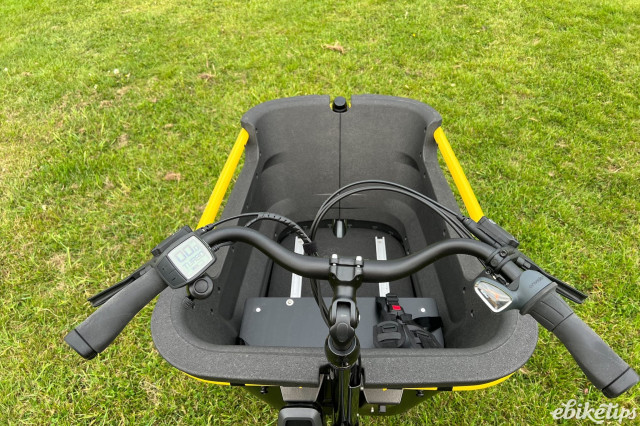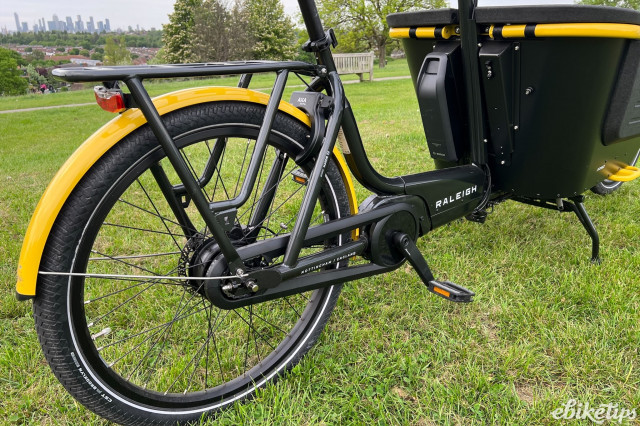Raleigh Stride 2 Family Cargo Bike
Overview
- Assistance kicks in very quickly
- Decent range
- Fun, practical and safe for the family
- Lock at the back has to have the key left in to operate the bike
- Size makes storage in anything but a garage difficult
- Tapered shape at the front makes fitting through gaps more difficult
The Raleigh Stride 2 Family Cargo Bike is a highly practical, spacious, and powerful e-cargo bike. It isn’t for those who need to store bikes anywhere except a garage though, as the size and weight make it very difficult to manoeuvre.
Design and components
The first thing to mention about the design is that at 2.6m, this is a very long bike. To put that in perspective, it is the length of a small car. This makes sense given that the Stride 2 is predominantly designed for transporting people and stuff around, but it will also unavoidably raise issues for some people.
Control of the bike is through the Bosch Purion display panel, which is practical and functional, offering five levels of assist from none through to turbo.
These are selected through the + and - buttons on the display. It also tells you the distance you’ve covered, your speed, and it allows you to control the lights too. It isn’t perhaps the most flashy screen I’ve ever seen, but it does exactly what’s needed without fuss.
The display is connected to Bosch’s top-of-the-line Performance Line CX motor. This is a powerful mid-motor that will provide assistance almost instantaneously. This is very important for a bike of this length that weighs 60kg. It means that when stopping and starting on hills, you only need a fraction of a second of ‘real’ effort before the motor kicks in. (Very convenient for me living on top of a 14% hill.) It also helps to keep the bike balanced at slower speeds, which given I was testing it in London was particularly important.
The basic layout of the bike is a classic Long John cargo shape, with the rider sitting towards the back and a large reinforced polystyrene ‘bucket’ at the front. The bucket is protected by large metal bars, which is necessary as one occasionally problematic design element is how it tapers. The bucket is widest in front of the rider and thinner at the front. This does two things: firstly, it makes it appear longer and secondly, it makes it difficult to judge gaps. From the scratch marks on the bars when I received the bike, it's clear that this is something that one or two previous reviewers had found too.
It meant that I couldn’t fit it through my front door; I often found myself slowly edging through bollards; and filtering was something I did only when there was at least 30cm clearance on each side. In general, it didn’t make a huge amount of difference to my rides, but it is something worth highlighting as it was a noticeable feature.
Inside the bucket, the version that I had featured a bench with two harnesses, which meant that I could comfortably take my daughter to nursery. It has a cargo capacity of 80kg too, which meant that I could drop her off and then go and pick up some bags of soil on the way back. It feels secure and sturdy and I would be confident of being able to carry pretty much anything short of a load of rubble.
In addition to the five assist levels, Raleigh has also included Enviolo stepless gearing which is controlled by a grip shift. I haven’t used a gripshift since I was a kid, so this was very nostalgic and it worked brilliantly. Despite living in a hilly part of South-East London and the bike weighing eight times what my normal bike does, there wasn’t any incline that posed a problem. This is testament to both the power of the motor and the gearing range.
The bike is kept secure with a Dutch lock at the back of the bike which locks through the back wheel. In most cases, this lock would not be enough to prevent somebody from stealing a bike, but given the sheer size and weight of this one, if you can’t roll it, you aren’t going to be able to move it. The one downside of this is that the key cannot be removed when it is unlocked, so you can’t attach it to your keyring (unless you want your house keys dangling around the spokes). It meant that on more than one occasion I found myself madly dashing around the house trying to find a single key not on a keyring.
Elsewhere Raleigh have added a useful luggage rack at the back. You know, in case the huge bucket in front of you isn’t quite enough storage.
Battery and range
The bike comes with a 500Wh battery that attaches to a dock at the back of the bucket. Removing it and locking it is done using the same key as the Dutch lock on the back wheel. This is useful because you don’t need multiple keys, but it’s also a little annoying because, as mentioned above, you can’t remove the key from the Dutch lock whilst it is unlocked.
Charging time is a claimed 4.5 hours, which is pretty much what I found. Due to the size of the bike and where I had to store it, it was essential that the battery was easy to take off and put back on – and it was. Charging is then done through a beefy charger which plugs into any mains socket.
When I initially set out on the bike, given its size and weight I wasn’t expecting much in the way of range. The claimed 40 miles max meant that I was expecting to make my 16-mile round-trip to work and back before having to charge it again. However, this was not the case and despite riding some steep hills and almost exclusively using the highest level of assistance, I found the battery would actually last two days of commuting – although I did need to drop it down a couple of assist levels in the last two miles.
Given the size and weight of the bike, combined with the kind of terrain I was testing it on, this seems pretty good. I would estimate that it was getting between 30-35 miles on a single charge, which is very impressive for something that needs a lot of power to get going.
Performance
The bike was delivered off the back of the delivery lorry and getting it into storage for the first time was a massive pain. It didn’t fit through doors, it was difficult to lift and it is too long to get around any normal corner. Luckily, I had planned for this, but it meant that I was feeling apprehensive when I first took it out.
I should not have been such a pessimist because this thing is an absolute joy to ride.
Despite it being so long, Raleigh have cut out a small section at the front of the bucket which allows you to see just enough of the front wheel that you can judge the road ahead. The turning circle isn’t amazing, but it never could be for something this long. Even so, I found that handling was impressive and I could easily stay stable and nimble, even in London traffic.
The assistance is great and tackled every hill I threw at it – given that this bike weighs as much as Chris Froome, that is impressive.
I took my daughter out in the bucket a few times too, which is ultimately the use of the bike that is most important. She loved being in there and with the large bars on the side, the secure and easily fitted (and adjusted) straps, plus the fact I could always see her, a lot of the anxiety around cycling with your child was removed.
RRP on the bike is £4,395 which is a large sum, but also what you can expect for this kind of an e-cargo bike that can realistically replace a car in most daily situations. Given the choice between a 2010 Ford Mondeo and this as a daily runaround, I know which I would prefer.
The Stride 2 is a similar price to the Tern GSD (£4,499). They are, however, different sorts of e-cargo bike. For a start, the Tern is a fair bit smaller - barely half the weight - and while it's also rated for 80kg of cargo, it's a longtail with the majority of its carrying capacity on the back.
The Riese & Müller Packster 40 Vario at £5,192 is another good option and more similar to the Raleigh in design. It’s a bit shorter though and the load capacity is nowhere close.
Overall, I really liked the Stride. There is no doubt there are some challenges to using it – like its length and the fact that it’s too wide to get through standard doors – but there is so much to like about it.
It’s like a manatee. When outside of its natural habitat it’s a bit too big and awkward, looks a bit strange, and doesn’t quite fit anywhere comfortably. However, once it’s in its natural surroundings, it blossoms and manages to be both graceful and practical. This may sound like poetic guff, but it’s justified – this is a really fun bike to use, whether I had my daughter sat in front or was just cruising to the office.
1 comments
Can an adult sit comfortably (and legally) in the "bucket"?
A general question: why is the saddle so far behind the bottom bracket on the majority of long johns? It looks like instant backache t me, as it's so different to the rest of my bicycles.
